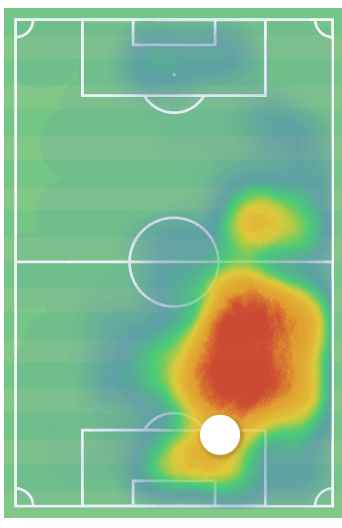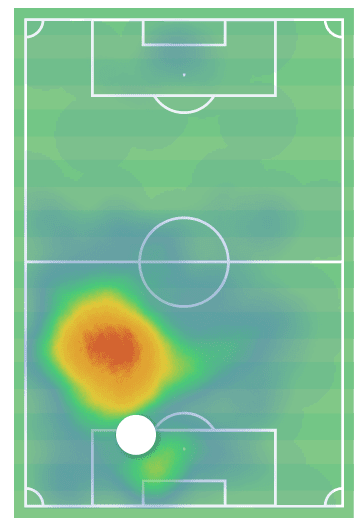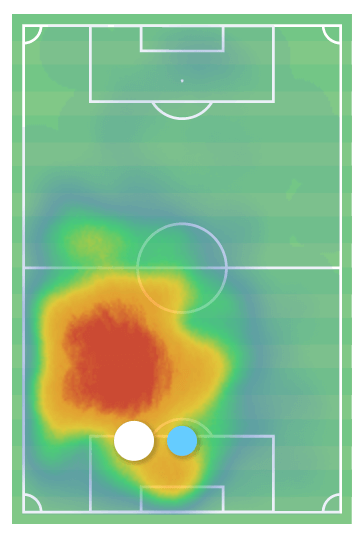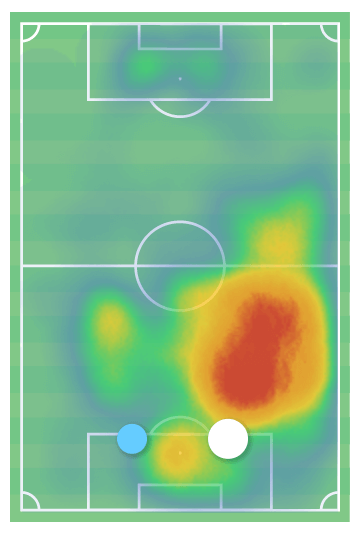Abdoulaye Seck is a 27-year-old central defender for Antwerp in the Belgium First Division A. The Senegalese, Seck, has been identified by Toni Bilandzic in his data analysis piece on centre-backs in Belgium. The data outlined Seck as an effective central defender overall, with impressive comparative data in defensive duels, aerial duels, interceptions and progressive passes. However, the Senegalese defender only made 13 league appearances throughout the 2019/20 season. Given his outstanding data in comparison to other Belgian league defenders, the question is, why is he not a regular starter for Antwerp? This data analysis will shed more light on this conundrum by delving into Seck’s statistics for the 2019/20 season in specific comparison to his Antwerp teammates, along with an analysis of Antwerp’s team performance.
Centre-back options at Antwerp
With the league data outlining Seck’s ability in comparison to all centre-backs in the league, including ex-Premier League players Vincent Kompany (Manchester City) and Wesley Hoedt (played also in La Liga and Serie A), it is difficult to pinpoint why he is not a regular starter for Antwerp, or additionally, why he hasn’t earned a move to a higher-ranked team. Now, of course, we must take the data with the considerations of team context, given the fact that data is produced via completed actions, therefore, a player for a lower-ranked team may have more opportunities to produce frequencies within defensive metrics and higher-ranked teams may produce more opportunity to build passing metrics. However, success rates are effective in diminishing such team variance, just as per 90 stats are for normalising minutes played. But, the data suggests Seck is a defender with impressive stats in a defensive and offensive sense. In addition to this, this maturity and supposed peak ability at 27 years old, added to his strong physical presence at 6ft 4in, everything seems to be in favour of Seck, so why isn’t he starting every match for Antwerp or earned himself a move to a higher-ranked team? By analysing Antwerp closely, we will be better placed to answer or at least learn more about this question by determining if he is actually under-utilised in comparison to other available centre-backs, the use of the players in multiple competitions rather than just the league and the data comparisons of the players and team performance at Antwerp.
Firstly, let’s take a look at the appearance and minute stats of central defenders at Antwerp. This will give us an indication of the options at Antwerp and how they are utilised in comparison to Seck. Firstly, we will just analyse league minutes.
| Player | Appearances | Minutes | Minutes Difference to Leader |
| Dino Arslanagić
|
21 | 1976 | N/A |
| Wesley Hoedt | 21 | 1938 | 38 |
| Abdoulaye Seck | 13 | 1012 | 964 |
| Dylan Batubinsika
|
4 | 382 | 1594 |
If we take a look at all competitions this time, with the addition of the Belgium Cup and the UEFA Europa League in 2019/20, we can see that Seck is utilised more than his counterparts in the cup competitions, but only slightly, cutting the gap to the minute leader by 141 minutes. This suggests that the utilisation of players remains similar depending on the competition. It is good to rule this out, as Seck might have featured much more in the supposedly more difficult Europa League competition, as well as the Belgian Cup depending on the draw of the opposition. If this was the case, the playing time might have been similar overall, therefore discrediting the theory that Seck isn’t a regular, or at least in an overall sense, we already knew he was utilised less than his teammates in the league. One key point is that research shows that there are no public records of the Senegalese, Seck, having any injuries throughout the 2019/20 season which have caused him to earn fewer minutes than his teammates.
| Player | Appearances | Minutes | Minutes Difference to Leader |
| Dino Arslanagić
|
26 | 2346 | N/A |
| Wesley Hoedt | 24 | 2243 | 103 |
| Abdoulaye Seck | 18 | 1523 | 823 |
| Dylan Batubinsika
|
8 | 814 | 1532 |
Due to the data, we can see that Arslanagić and Hoedt are the favoured centre backs overall, with Seck seemingly competing with these players along with Dylan Batubinsika for a starting spot.
Another point to consider is the footedness of the players. Antwerp predominantly play with a 4-2-3-1 formation. The most balanced and comfortable set up for defending and showing players away from goal when engaging and trying to win the ball, or when pulled out wide, is to have a left-footed central defender on the left side of the two centre backs, and a right-footed centre back on the right side. Additionally, this is beneficial for playing out, given the easier nature of playing out to full-backs in wide areas to stretch the pitch and move the ball out of dangerous areas easily. In the same way, central midfielders who pull wider of their markers can be found, which is an easier progressive pass to play when the footedness of the player matches the side of the pitch they are playing on. With this in mind, we can see in the table below that Hoedt is the only left-footed central defender for Antwerp. We know from the data analysis on the league that Hoedt is impressive in reputation, data and his footedness which makes him the prime choice for the LCB spot. From there, it seems that there is a three-way competition between Seck, Batubinsika and Arslanagić, who are all right-footed, for the RCB spot.
| Player | Footedness |
| Dino Arslanagić
|
Right |
| Wesley Hoedt | Left |
| Abdoulaye Seck | Right |
| Dylan Batubinsika
|
Right |
However, when looking into each player in more detail, the heat maps of each player contradict this. It now appears that Hoedt is the first choice at LCB and Batubinsika is the backup. For RCB, Seck and Arslanagić are the preferred options. In some matches, Seck has been utilised at LCB (3), but he is predominantly utilised on the right side to benefit the use of his right foot.




Seck vs Arslanagić
Ok, so now we know which specific comparison to make. Seck vs Arslanagić for the RCB position. Of course, it is perfectly acceptable for squad rotation to be the reason for the shared minutes. It is not commonplace to rotate central defenders as much as other playing positions, but with the Antwerp manager seemingly having four central defenders whom he trusts, albeit some more so than others, rotating to keep players fresh and performances high during three competitions is, of course, effective squad management. In addition, it will be difficult and a touch foolish to suggest any definitive conclusions from any comparisons made. But, we do know that Seck features less than Arslanagić, and the data analysis piece by Toni Bilandzic suggests Seck to be a standout player, an analysis piece which also featured Arslanagić. But, the comparison may give us more information to base our judgements on.
To enhance the amount of data in the hope of increased reliability, the sample will include the Belgium Cup and UEFA Europa League in addition to the Belgian league performances. Given both players featured in the additional competitions, any cross competition influence should be reduced. The matches Seck has played at LCB (3) have been removed to ensure both players are compared on their strongest side.
All data featured within this piece are averaged Per 90 stats, to limit the influence of minutes played on output averages. Frequency and success or win percentages are presented. The successful frequency per action can also be seen within the brackets in the percentage columns, providing more insight into how many attempts were successful per game.
| Player | Defensive Duels | Defensive Duels Win % | Aerial Duels | Aerial Duels Win % | Sliding Tackles | Sliding Tackles Win % | Shots Blocked | Interceptions | Fouls |
| Seck | 8.57 | 77.93 (6.68) | 8.51 | 68.06 (5.8) | 0.65 | 36.36 (0.24) | 0.59 | 7.21 | 1.12 |
| Arslanagić | 6.02 | 62.42 (3.76) | 6.68 | 58.05 (3.88) | 0.46 | 58.33 (0.27) | 0.42 | 4.1 | 1.57 |
The defensive metrics show Seck to have the advantage, with a higher or superior frequency and success percentage in five of the six defensive metrics, with Arslanagić only beating his teammate in terms of slide tackle success. Seck is higher in terms of frequency. This reinforces the previous data analysis work on the Belgian league, in which Seck stood out and Arslanagić was deemed average in most defensive metrics. Such data analysis maintains the previous findings in most metrics, with Seck superior, although for sliding tackles, Arslanagić actually completes more successful attempts per match, despite attempting fewer on average.
| Player | xG | Dribbles | Dribbles Success % | Passes | Passes Accuracy % | Forward Passes | Forward Passes Accuracy % | Long Passes | Long Passes Accuracy % |
| Seck | 0.03 | 0.83 | 71.43 (0.59) | 37.05 | 79.74 (29.54) | 19.09 | 70.59 (13.5) | 8.51 | 61.81 (5.26) |
| Arslanagić | 0.04 | 0.35 | 33.33 (0.12) | 32.15 | 88.07 (28.31) | 14.19 | 80 (11.35) | 5.41 | 70.92 (3.84) |
| Player | Final 3rdPasses | Final 3rdPasses Accuracy% | Passes To Penalty Area | Passes to Penalty Area Accuracy % | Thru Passes | Deep Completions | Progressive Passes |
| Seck | 8.21 | 62.59 (5.14) | 1.36 | 39.13 (0.53) | 0.47 | 0.65 | 9.46 |
| Arslanagić | 4.3 | 79.46 (3.42) | 0.35 | 33.33 (0.12) | 0.04 | 0.23 | 7.29 |
The offensive metrics show a varied story. As outlined in the league-wide data analysis piece, Seck demonstrates impressive offensive stats in terms of dribbling and passing. Seck is superior to Arslanagić in terms of dribbling frequency and percentage success, he is therefore superior at stepping out of defence and carrying the ball. Seck is also superior in terms of frequency in many of the passing metrics, for example, passes, forward passes, long passes, final third passes, passes to the penalty area, through passes, deep completions and progressive passes. However, the common theme within such passing metrics, apart from passes into the penalty area, is that Arslanagić has a higher success rate. Therefore, whilst Arslanagić attempts fewer passes of a varied kind, he is more accurate with those he does attempt. Of course, there is the argument of attempting more leading to more errors. This can be placed into context by looking at the success frequencies in the brackets of the success rate columns. Seck still outputs higher successful frequencies for passes, forward passes, long passes, final third passes and passes to the penalty area. Of course, it is for the analysis team and coaching staff to interpret these stats and determine what they want from their central defender. But, it appears that Seck is attracted to the ball more than Arslanagić, with Seck more willing and confident to carry the ball and play passes of a short, long or progressive kind. Because of this, he completes more passes of this kind on average, which can benefit the team in an attacking sense but also increases the risk of losing the ball. Arslanagić seems to be a safer player, with higher accuracies and lower frequencies.
Overall, based on individual data, Seck is the superior defender and contributes more in an attacking sense, although with the increased reward of Seck comes increased risk compared to Arslanagić, this may be a factor for the coaching staff at Antwerp. But again, the data does state Seck’s superiority.
How the CBs influence team performance
So, we’ve taken a look at the individual data which again suggests Seck’s superiority in an offensive and defensive sense. So, what about the more obvious information when either player is selected in the RCB position? Do team performances and results change to give the coaching staff some team output reasons for selecting Arslanagić more than Seck?
Only matches where the player played more than 30 minutes are included due to a number of single figure substitute appearances limiting the players’ influence in those appearances. Any game where both players featured has also been omitted.
| Player | Win % | PPG | xG For | Goal For | xG Against | Goals Against | Shots Against | Shots On Target Against |
| Seck | 45.5 | 1.54 | 1.67 | 1.73 | 1.38 | 1.27 | 12 | 4.6 |
| Arslanagić | 47.6 | 1.81 | 1.65 | 1.67 | 1.23 | 1.14 | 11.24 | 3.81 |
The findings of the team analysis are very interesting and reinforce the notion that the analysts and coaching staff may be looking into their data in a team output sense, rather than an individual sense. Team performance is, of course, the priority, with individual performances and development hopefully contributing to team performance. In this case, whilst Seck’s data is dominant on an individual basis, when Arslanagić is selected, the team benefits. When Arslanagić is selected, the team has a higher win percentage, higher points per game and the xG and goals for remains similar suggesting Seck’s offensive performance has little impact. When Arslanagić is selected the team also concede fewer xG against, they concede fewer goals, fewer shots and fewer shots on target. As stated, for Antwerp, this is the most important thing and this is potentially the reason why Arslanagić is selected for the RCB position more than Seck.
Conclusion
To conclude, Seck produces impressive individual data in a league-wide sense. However, with superior data but fewer starts and minutes than his positional teammates, this specific data analysis piece investigated why the player doesn’t start more. Overall, it appears that Seck does play less when all competitions are considered, although he is still well utilised with 18 appearances in a shortened season. Hoedt has locked down the LCB position given his left-footed nature, reputation and performances. For the RCB position, Seck is in competition with Arslanagić. When the competing players were compared it appeared strange as Seck is superior in defensive and offensive metrics. However, the key to the decision to play Arslanagić more appears to lie within the team data when Arslanagić is selected instead of Seck. All defensive metrics improve whilst offensive metrics remain relatively unchanged, therefore highlighting Arslanagić as the better fit for team success. It would be interesting to investigate Antwerp in more detail and analyse Seck and Arslanagić in a subjective sense to uncover more information, although additional information regarding training performance and coach-player relationships will always remain unknown. However, for now, the question regarding Seck’s slight lack of selection appears to relate to overall team performance.






Comments